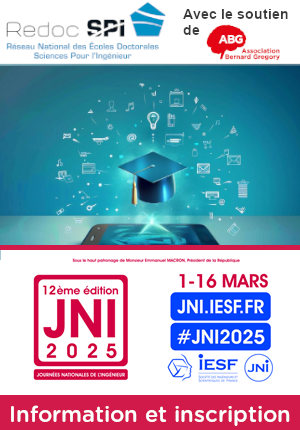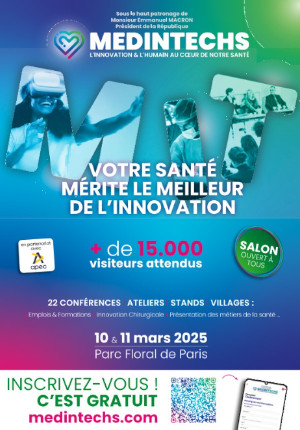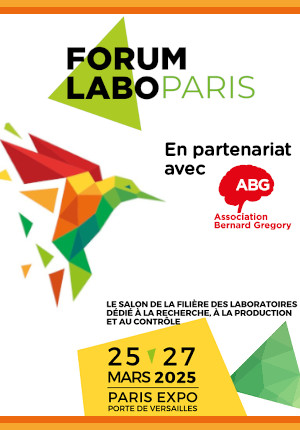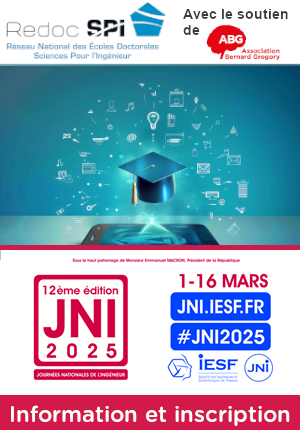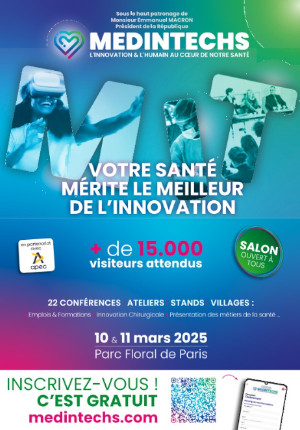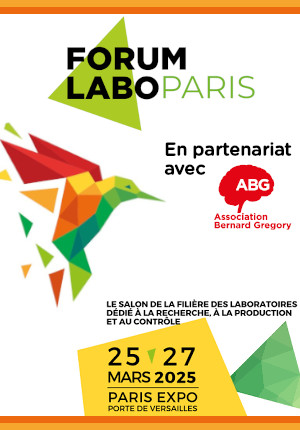Quand matière organique et phyllosilicates se rencontrent dans les météorites // When organics meet phyllosilicates in chondrites
|
ABG-128699
ADUM-61638 |
Sujet de Thèse | |
| 18/02/2025 |
Université de Lille
VILLENEUVE D'ASCQ CEDEX - France
Quand matière organique et phyllosilicates se rencontrent dans les météorites // When organics meet phyllosilicates in chondrites
- Terre, univers, espace
cosmochimie, microscopie, matière organique, hydrothermalisme
cosmochemistry, microscopy, organic matter, aqueous alteration
cosmochemistry, microscopy, organic matter, aqueous alteration
Description du sujet
Les météorites sont les témoins de la formation du système solaire. Parmi elles, les chondrites carbonées sont riches d'une matière organique complexe, dont les origines restent difficiles à établir.
Certaines signatures isotopiques pointent vers une origine interstellaire, d'autres vers une synthèse dans le disque protoplanétaire, et il y a aussi des arguments en faveur d'une évolution pendant les épisodes d'hydrothermalisme au sein des astéroides.
Nous souhaitons pour cette thèse étudier la dernière hypothèse et en particulier les interactions entre la matière organique et une classe de minéraux sillicatés hydratés organisés en feuillets, les phyllosilicates. Les travaux récents ont montrés que ces deux “composants” étaient intriqués à l'échelle nanométrique, suggérant une influence physico-chimique réciproque. Mais quelle est l'échelle spatiale de cette interaction ? Les molécules organiques sont elles présentes dans la porosité ou dans les espaces interfoliaires des phyllosilicates ? Y-a-t-il une selectivité chimique qui dépend de la nature des phyllosilicates ? Comment tout cela controle-t-il les transformations de chaque composant ?
Pour y répondre, le candidat utilisera un microscope electronique à transmission, capable d'imager les objets à l'échelle requise. L'objectif sera de mettre en évidence les relations organiques/phyllosilicates en trois dimensions par tomographie en imagerie (dark field images) et en spectroscopie de perte d'énergie (EELS), et de coupler les informations élémentaires (O/C, N/C, S/C) et la spéciation des molécules (aromatiques, aliphatiques, etc..)
Un des challenge sera de parvenir à mesurer ces composants qui sont sensibles sous le faisceau d'électrons. Des méthodes d'acquisition dédiées devront donc être développées sur la base de matériaux de référence, avant d'analyser des chondrites et des échantillons d'astéroides ramenés par les missions spatiales Hayabusa2 (Ryugu) et OSIRIS-REX (Bennu).
Contexte:
La bourse de thèse sera attribuée par l'université de Lille, et le projet est soutenu par ailleurs par le programme PEP ORIGINS. Le candidat idéal aura une experience prélable soit en cosmochimie, en geochimie organique ou en science des matériaux et/ou microscopie electronique. Des notions de python pour l'analyse de données serait un avantage.
• Laboratoire: Unité Matériaux et Transformation (UMET)
• Encadrement: Corentin Le Guillou and Hugues. Leroux
• Collaboration: Maya Marinova, Damien Jacob, Francisco De La Peña
Pour candidater, envoyer CV et motivations à Corentin Le Guillou: corentin.le-guillou@univ-lille.fr
→ https://umet.univ-lille.fr/detailscomplets.php?id=505&&lang=en
Publications en lien avec le projet:
- Le Guillou, et al. (2014). Evolution of organic matter in Orgueil, Murchison and Renazzo during parent body aqueous alteration: In situ investigations. Geochimica et Cosmochimica Acta, 131, 368-392.
- Viennet, et al. (2022). Experimental investigation of Fe-clay/organic interactions under asteroidal conditions. Geochimica et Cosmochimica Acta, 318, 352-365.
- Leroux et al. (2024). Phyllosilicates with embedded Fe‐based nanophases in Ryugu and Orgueil. Meteoritics & Planetary Science, 59(8), 1947-1965.
- De Gregorio et al. (2024). Variations of organic functional chemistry in carbonaceous matter from the asteroid 162173 Ryugu. Nature Communications, 15(1), 7488.
------------------------------------------------------------------------------------------------------------------------------------------------------------------------
------------------------------------------------------------------------------------------------------------------------------------------------------------------------
Meteorites bear witness to the formation of the solar system. Among them, carbonaceous chondrites are rich in complex organic matter, the origins of which remain complex to establish.
Some isotopic signatures point to an interstellar origin, others to synthesis in the accretion disk, and there are also arguments for a physico-chemical evolution during the hydrothermal episodes that take place within asteroids.
For this PhD project, we want to investigate this last hypothesis, and in particular the interactions between organic matter and phyllosilicates. Recent studies have shown that these two ‘components' are mixed at the nanometric scale, suggesting that they influence each other. But what is the spatial scale of this interaction? Are there organic molecules present in the porosity? In the interlayer space of the phyllosilicates? Is there a chemical selectivity depending on the nature of the phyllosilicates? How does this determine the transformations of each component?
To answer these questions, the candidate will study organic matter using a transmission electron microscope capable of achieving the required spatial resolution. The aim of the project will be to reveal the interaction between organic matter and phyllosilicates in three dimensions (tomography) using HAADF imaging and electron loss spectroscopy to determine the elemental composition and speciation of organic molecules.
Context :
The thesis grant will be awarded by the University of Lille, and the project is supported by the PEPR ORIGINS. The ideal candidate will have previous experience in one of these disciplines: cosmochemistry, organic geochemistry, materials science and/or electron microscopy. scientific programming will be an advantage.
• Laboratory: Unité Matériaux et Transformation (UMET)
• PhD advisors: Corentin Le Guillou and Hugues. Leroux
• Collaborators: Maya Marinova, Damien Jacob, Francisco De La Peña
To apply, please send a CV and a motivation letter to Corentin Le Guillou:
- corentin.le-guillou@univ-lille.fr
- https://umet.univ-lille.fr/detailscomplets.php?id=505&&lang=en
Publications related to the project:
- Le Guillou, et al. (2014). Evolution of organic matter in Orgueil, Murchison and Renazzo during parent body aqueous alteration: In situ investigations. Geochimica et Cosmochimica Acta, 131, 368-392.
- Viennet, et al. (2022). Experimental investigation of Fe-clay/organic interactions under asteroidal conditions. Geochimica et Cosmochimica Acta, 318, 352-365.
- Leroux et al. (2024). Phyllosilicates with embedded Fe‐based nanophases in Ryugu and Orgueil. Meteoritics & Planetary Science, 59(8), 1947-1965.
- De Gregorio et al. (2024). Variations of organic functional chemistry in carbonaceous matter from the asteroid 162173 Ryugu. Nature Communications, 15(1), 7488.
However, hydrated silicates and carbonaceous matter are electron-beam sensitive, preventing their full characterisation at the atomic scale using currently available nanoanalysis methods, and dedicated acquisition methods should be applied. Reference material, chondrites and sample return mission samples (Hayabusa2 from Ryugu, OSIRIS-REX from Bennu) will be studied.
------------------------------------------------------------------------------------------------------------------------------------------------------------------------
------------------------------------------------------------------------------------------------------------------------------------------------------------------------
Début de la thèse : 01/10/2025
Certaines signatures isotopiques pointent vers une origine interstellaire, d'autres vers une synthèse dans le disque protoplanétaire, et il y a aussi des arguments en faveur d'une évolution pendant les épisodes d'hydrothermalisme au sein des astéroides.
Nous souhaitons pour cette thèse étudier la dernière hypothèse et en particulier les interactions entre la matière organique et une classe de minéraux sillicatés hydratés organisés en feuillets, les phyllosilicates. Les travaux récents ont montrés que ces deux “composants” étaient intriqués à l'échelle nanométrique, suggérant une influence physico-chimique réciproque. Mais quelle est l'échelle spatiale de cette interaction ? Les molécules organiques sont elles présentes dans la porosité ou dans les espaces interfoliaires des phyllosilicates ? Y-a-t-il une selectivité chimique qui dépend de la nature des phyllosilicates ? Comment tout cela controle-t-il les transformations de chaque composant ?
Pour y répondre, le candidat utilisera un microscope electronique à transmission, capable d'imager les objets à l'échelle requise. L'objectif sera de mettre en évidence les relations organiques/phyllosilicates en trois dimensions par tomographie en imagerie (dark field images) et en spectroscopie de perte d'énergie (EELS), et de coupler les informations élémentaires (O/C, N/C, S/C) et la spéciation des molécules (aromatiques, aliphatiques, etc..)
Un des challenge sera de parvenir à mesurer ces composants qui sont sensibles sous le faisceau d'électrons. Des méthodes d'acquisition dédiées devront donc être développées sur la base de matériaux de référence, avant d'analyser des chondrites et des échantillons d'astéroides ramenés par les missions spatiales Hayabusa2 (Ryugu) et OSIRIS-REX (Bennu).
Contexte:
La bourse de thèse sera attribuée par l'université de Lille, et le projet est soutenu par ailleurs par le programme PEP ORIGINS. Le candidat idéal aura une experience prélable soit en cosmochimie, en geochimie organique ou en science des matériaux et/ou microscopie electronique. Des notions de python pour l'analyse de données serait un avantage.
• Laboratoire: Unité Matériaux et Transformation (UMET)
• Encadrement: Corentin Le Guillou and Hugues. Leroux
• Collaboration: Maya Marinova, Damien Jacob, Francisco De La Peña
Pour candidater, envoyer CV et motivations à Corentin Le Guillou: corentin.le-guillou@univ-lille.fr
→ https://umet.univ-lille.fr/detailscomplets.php?id=505&&lang=en
Publications en lien avec le projet:
- Le Guillou, et al. (2014). Evolution of organic matter in Orgueil, Murchison and Renazzo during parent body aqueous alteration: In situ investigations. Geochimica et Cosmochimica Acta, 131, 368-392.
- Viennet, et al. (2022). Experimental investigation of Fe-clay/organic interactions under asteroidal conditions. Geochimica et Cosmochimica Acta, 318, 352-365.
- Leroux et al. (2024). Phyllosilicates with embedded Fe‐based nanophases in Ryugu and Orgueil. Meteoritics & Planetary Science, 59(8), 1947-1965.
- De Gregorio et al. (2024). Variations of organic functional chemistry in carbonaceous matter from the asteroid 162173 Ryugu. Nature Communications, 15(1), 7488.
------------------------------------------------------------------------------------------------------------------------------------------------------------------------
------------------------------------------------------------------------------------------------------------------------------------------------------------------------
Meteorites bear witness to the formation of the solar system. Among them, carbonaceous chondrites are rich in complex organic matter, the origins of which remain complex to establish.
Some isotopic signatures point to an interstellar origin, others to synthesis in the accretion disk, and there are also arguments for a physico-chemical evolution during the hydrothermal episodes that take place within asteroids.
For this PhD project, we want to investigate this last hypothesis, and in particular the interactions between organic matter and phyllosilicates. Recent studies have shown that these two ‘components' are mixed at the nanometric scale, suggesting that they influence each other. But what is the spatial scale of this interaction? Are there organic molecules present in the porosity? In the interlayer space of the phyllosilicates? Is there a chemical selectivity depending on the nature of the phyllosilicates? How does this determine the transformations of each component?
To answer these questions, the candidate will study organic matter using a transmission electron microscope capable of achieving the required spatial resolution. The aim of the project will be to reveal the interaction between organic matter and phyllosilicates in three dimensions (tomography) using HAADF imaging and electron loss spectroscopy to determine the elemental composition and speciation of organic molecules.
Context :
The thesis grant will be awarded by the University of Lille, and the project is supported by the PEPR ORIGINS. The ideal candidate will have previous experience in one of these disciplines: cosmochemistry, organic geochemistry, materials science and/or electron microscopy. scientific programming will be an advantage.
• Laboratory: Unité Matériaux et Transformation (UMET)
• PhD advisors: Corentin Le Guillou and Hugues. Leroux
• Collaborators: Maya Marinova, Damien Jacob, Francisco De La Peña
To apply, please send a CV and a motivation letter to Corentin Le Guillou:
- corentin.le-guillou@univ-lille.fr
- https://umet.univ-lille.fr/detailscomplets.php?id=505&&lang=en
Publications related to the project:
- Le Guillou, et al. (2014). Evolution of organic matter in Orgueil, Murchison and Renazzo during parent body aqueous alteration: In situ investigations. Geochimica et Cosmochimica Acta, 131, 368-392.
- Viennet, et al. (2022). Experimental investigation of Fe-clay/organic interactions under asteroidal conditions. Geochimica et Cosmochimica Acta, 318, 352-365.
- Leroux et al. (2024). Phyllosilicates with embedded Fe‐based nanophases in Ryugu and Orgueil. Meteoritics & Planetary Science, 59(8), 1947-1965.
- De Gregorio et al. (2024). Variations of organic functional chemistry in carbonaceous matter from the asteroid 162173 Ryugu. Nature Communications, 15(1), 7488.
However, hydrated silicates and carbonaceous matter are electron-beam sensitive, preventing their full characterisation at the atomic scale using currently available nanoanalysis methods, and dedicated acquisition methods should be applied. Reference material, chondrites and sample return mission samples (Hayabusa2 from Ryugu, OSIRIS-REX from Bennu) will be studied.
------------------------------------------------------------------------------------------------------------------------------------------------------------------------
------------------------------------------------------------------------------------------------------------------------------------------------------------------------
Début de la thèse : 01/10/2025
Nature du financement
Précisions sur le financement
Financement d'un établissement public Français
Présentation établissement et labo d'accueil
Université de Lille
Etablissement délivrant le doctorat
Université de Lille
Ecole doctorale
104 Sciences de la Matière du Rayonnement et de l'Environnement
Profil du candidat
Le candidat idéal aura une experience prélable soit en cosmochimie, en geochimie organique ou en science des matériaux et/ou microscopie electronique. Des notions de python pour l'analyse de données serait un avantage.
The ideal candidate will have previous experience in one of these disciplines: cosmochemistry, organic geochemistry, materials science and/or electron microscopy. scientific programming will be an advantage.
The ideal candidate will have previous experience in one of these disciplines: cosmochemistry, organic geochemistry, materials science and/or electron microscopy. scientific programming will be an advantage.
19/05/2025
Postuler
Fermer
Vous avez déjà un compte ?
Nouvel utilisateur ?
Besoin d'informations sur l'ABG ?
Vous souhaitez recevoir nos infolettres ?
Découvrez nos adhérents
 Généthon
Généthon  CESI
CESI  Institut de Radioprotection et de Sureté Nucléaire - IRSN - Siège
Institut de Radioprotection et de Sureté Nucléaire - IRSN - Siège  Institut Sup'biotech de Paris
Institut Sup'biotech de Paris  Aérocentre, Pôle d'excellence régional
Aérocentre, Pôle d'excellence régional  Tecknowmetrix
Tecknowmetrix  Nokia Bell Labs France
Nokia Bell Labs France  ADEME
ADEME  ONERA - The French Aerospace Lab
ONERA - The French Aerospace Lab  PhDOOC
PhDOOC  Laboratoire National de Métrologie et d'Essais - LNE
Laboratoire National de Métrologie et d'Essais - LNE  Groupe AFNOR - Association française de normalisation
Groupe AFNOR - Association française de normalisation  TotalEnergies
TotalEnergies  CASDEN
CASDEN  SUEZ
SUEZ  Ifremer
Ifremer  MabDesign
MabDesign  ANRT
ANRT  MabDesign
MabDesign



